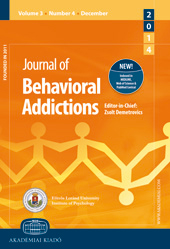Commentary on: Muscle dysmorphia: Could it be classified as an addiction to body image?
Commentary on: Muscle dysmorphia: Could it be classified as an addiction to body image?
Author(s): Johanna E. NieuwoudtSubject(s): Psychology of Self, Behaviorism, Substance abuse and addiction, Health and medicine and law, Demography and human biology, Sports Studies
Published by: Akadémiai Kiadó
Keywords: muscle dysmorphia; classification; body dysmorphic disorder; behavioural addiction; body image; Diagnostic and Statistical Manual of Mental Disorders (DSM);
Summary/Abstract: The article titled ‘Muscle dysmorphia: Could it be classified as an addiction to body image?’ used Griffiths (2005) addiction components model as the framework in which to define muscle dysmorphia (MD) as an addiction. The authors (Foster, Shorter & Griffiths, 2014) proposed that MD could be re-classified as an addiction to body image. Method and aim: In response to the original article, the author of this commentary reflected on the ‘Addiction to body image’ model and the components of addiction as described in the context of MD. This invited commentary aimed to provide opposing viewpoints in order to give a balanced overview on the topic. Results: It appears as if the components of addictions can be used as a framework in which to define MD. However, systematic empirical evidence had not been provided for the withdrawal symptoms associated with this behavioral addiction. An opposing viewpoint is provided in response to Foster et al.’s (2014) statement that MD is different from other body dysmorphic disorders in regards to cognitive dysfunction, and therefore cannot be explained in the same way. Conclusions: Based on the little systematic empirical evidence to date, it may be a bit premature to re-classify MD as an addiction to body image.
Journal: Journal of Behavioral Addictions
- Issue Year: 4/2015
- Issue No: 1
- Page Range: 8-10
- Page Count: 3
- Language: English

